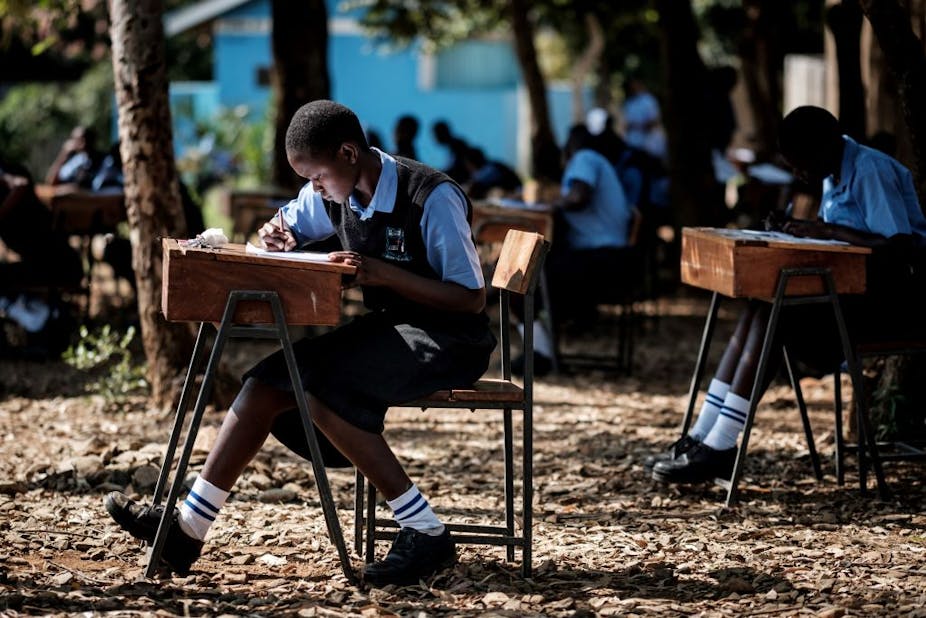Since its earliest traces, at least 5,000 years ago, formal education – meaning an education centred on literacy and numeracy – has always been highly selective. Ancient Egyptian priest schools and schools for scribes in Sumeria were only open to the children of the clergy or future monarchs.
Later on, the wealthy would use private tutors, such as the Sophists of Athens (500 - 400 BCE). Ancient Greek schools, such as Plato’s Academy and Aristotle’s Lyceum, were restricted to a small elite group. Formal education was reserved for male children who were wealthy, able, and privileged.
Through time, even after learning societies began to flourish, it was still an education for some and not for everybody.
In the 1800s Black people were denied access to quality education in the United States. In European colonies, education was used to strip people of their cultural heritage and relegate them to a future of menial labour.
Education has always been less accessible to women than men. Even today, over 130 million girls are still out of school. Although the difference between girls and boys is lessening, the disparity disadvantaging girls persists. From a socioeconomic perspective, in many countries, private schools continue to grow alongside compulsory state schools, offering a different style of education, sometimes at a very high price.
Today, progress to attain the dream of universal access to education is slow. UNESCO’s Education for All and the UN’s Sustainable Development Goal 4, which aims to “ensure inclusive and equitable quality education and promote lifelong learning opportunities for all”, are still far from materialising: roughly 260 million children are still not in school . The COVID-19 pandemic has made the situation worse: remote learning is inaccessible to roughly 500 million students. Estimates are that over 200 million children will still be out of school by 2030.
In my study “Education and Elitism”, the overarching question that runs through the book is about the future of education worldwide: What are the prospects for the future? Are we facing an even more enclaved, pauperised majority while a tiny minority become more powerful and wealthy?
Certain paths could open up. On the one hand, places in selective institutions could become even more difficult to access while private education strips ahead of national standards. On the other hand, changes might make education more inclusive: this would include scholarships, cheaper private education, more robust state systems and deep assessment reform.
Prospects for the future
Scholarship programmes: These allow the brightest and poorest access to transformative learning ecosystems. However, this contributes to a brain drain and does not develop the local educational sector, particularly in Africa.
Cheaper private education: A movement of accessible private schools is growing. This allows more children to access some of the value-added features of such systems – more curriculum flexibility, smaller class sizes, more individual student tracking. However, there are reports that this is widening social divides, as the public system isn’t improving fast enough to keep up.
More robust state systems: UNESCO estimates that it would cost a total of US$340 billion each year to achieve universal pre-primary, primary, and secondary education in low- and lower-middle-income countries by 2030. The average annual per-student spending for quality primary education in a low-income country is predicted to be US$197 in 2030. This creates an estimated annual gap of US$39 billion between 2015 and 2030. Financing this gap calls for action from private sector donors, philanthropists, and international financial institutions.
Online learning: The COVID-19 lockdown has brought inequalities to the surface. However, the rise of online learning worldwide has been phenomenal. This opens up the potential to widen access to learning socioeconomically and, if delivered by skilled facilitators, academically. There is a problem, though: online instruction lacks the emotional quantum that face-to-face learning creates. Because of this, motivation levels and persistence tend to be low in online learning environments. And importantly, in many countries, many students still don’t have access to the internet.
A way forward: reforming the system
Perhaps the most substantive movement to reduce inequalities would not be to accelerate access to a broken system but to reform the system itself.
It is time to look further than narrow academic metrics as the only way of describing young people’s competences. The whole educational system across high schools, in every country, needs to change dramatically. Assessment models should recognise and nurture more varied and multiple competences, in particular, attitudes, skills and types of knowledge beyond those concentrated in constructs that are favoured by socioeconomic background, such as literacy and numeracy.
Read more: Education needs a refocus so that all learners reach their full potential
Until universities and employers look beyond traditional metrics, it will be difficult to break a circuit that favours, for the large part, middle class, socially and ethnically privileged candidates.
To truly break away from a millennia of elitist, selective systems, the approach needs to move from pure academics to a credit system that captures many more stories of learning. This new credit system should be known as a passport, meaning students have stamped it with the various competences such as lifelong learning and self-agency that they have developed throughout their learning (in an out of school), allowing them to be recognised on numerous different fronts.
A coalition of schools from every continent is working on this project, now seeking universities to sit around the table in order to bring this work to its conclusion. This would mean co-designing an elegant, life worthy transcript to allow more access to more children based on more expansive criteria.

